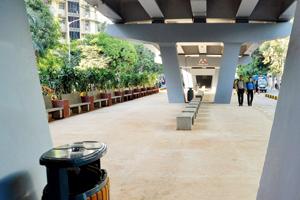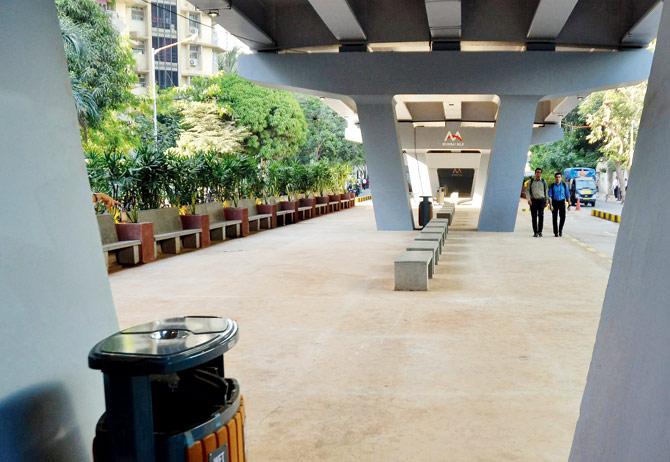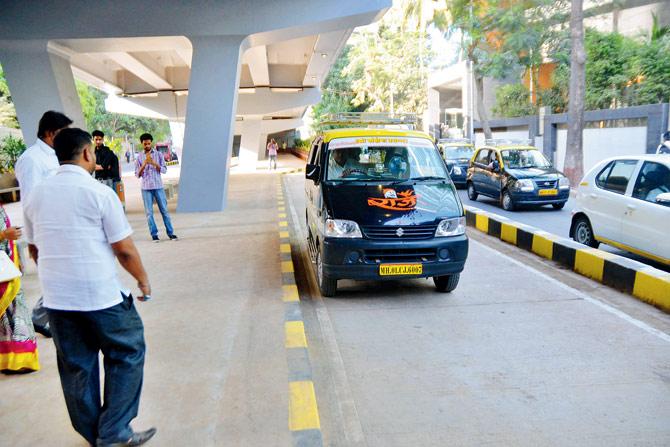The facelift underneath the Fergusson flyover is just the beginning of a mile-long project in an area where infrastructure needs to keep up with the upscale facilities


The underbelly of one end of Ferguson flyover is a pedestrian walkway.
ADVERTISEMENT
After five months of hard work, the underbelly of Fergusson flyover has been transformed into a beautiful public space, complete with a pedestrian walkway and benches for people to sit, as well as dustbins and pay-and-use toilets. The 250-metre stretch at the north end of the Lower Parel flyover is just a glimpse of what is to come in the larger Mumbai Mile project.
Parel has seen a significant change in character and is the signal bearer of the mills-to-malls change in Mumbai. Once corporate offices replaced mills' chimneys, and residential high-rises rubbed shoulders with their commercial cousins, flyovers sprung up for connectivity.

A cab veers into the taxi bay. Pics/Datta Kumbhar
Pedestrian-friendly
The non-profit Mumbai Mile Regeneration Association (MMRA) inaugurated the 250-metre stretch, which is Phase I of the proposed transformation of the 2-km belt (roughly 1 mile) underneath the flyover. The launch took place on Tuesday evening, with several movers and shakers behind this project talking about forthcoming plans for the entire stretch. Said Sanjay Toshniwal, MMRA co-promoter, "The point was to decongest Senapati Bapat Marg and make it easier for people to walk. The infrastructure here is not keeping pace with the high-end facilities."
The underbelly of the flyover was a smooth, clean stretch for pedestrians. Benches lined the side of the stretch and dustbins marked wet and dry waste were testament to the Swachch Bharat message. Pay-and-use toilets were still being constructed on one end of the space. The most interesting feature was a taxi bay on both sides of the space, so that cabbies can turn in and drop off passengers, avoiding traffic snarls. This five-month initiative, which puts a smile in the mile, now needs to be maintained so that it does not go to seed.
Chawls equal to malls
MLA Sunil Govind Shinde of the Shiv Sena said, "The beginning of the project has exceeded expectations. Malls may be the attraction here, but this is a place where locals live in chawls and old buildings. The younger generation is now earning well and they can afford to buy bikes, cars. That is why we see a real parking crunch in this area." Shinde stressed the need for involving locals in dialogue when community projects are taken up. "We cannot leave out a certain demographic, saying 'Why should we speak to people who live in chawls?'"
The MLA's candour evoked a few uncomfortable laughs, as he went on, "I am proud to be a Shiv Sainik, there is no problem in saying that. I am here as a mediator helping to take this concept ahead. Some people may accuse us of dadagiri, but there is no dadagiri ever for personal reasons. If there is any such thing, it is for the good of the people. "People in old buildings in Parel are as much stakeholders in the area as those in swanky, new high-rises."
For speaker Arvind Subramanian, regional chief executive officer (CEO) of the Lodha Group, "This is about creating urban spaces that go with the world-class boulevard this area has become. We have to make this citizen-friendly, traffic-friendly, and this is just one small step in a longer journey." Shveta Shah of Studio Pomegranate, which designed the space, also emphasised how important it is that "locals support the project."
Catch up on all the latest Mumbai news, crime news, current affairs, and also a complete guide on Mumbai from food to things to do and events across the city here. Also download the new mid-day Android and iOS apps to get latest updates
 Subscribe today by clicking the link and stay updated with the latest news!" Click here!
Subscribe today by clicking the link and stay updated with the latest news!" Click here!






